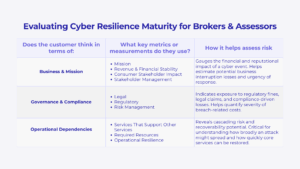In the world of cyber resilience, it’s no longer enough to have a disaster recovery plan that promises to “bring everything back.” As John Murphy, CISO-in-Residence at Rubrik, explained during our recent masterclass, “Securing Business-Critical Systems,” the organizations that survive disruption are those that focus on what truly matters first, the Minimum Viable Business (MVB).
Catch up with the full recording now: Securing Business-Critical Systems: Practical Strategies for Cyber Insurance Professionals for BI Mitigation
From Business Continuity to Minimum Viable Business
Traditional business continuity planning has long focused on comprehensive recovery through restoring all systems, locations, and processes. The Minimum Viable Business framework takes a more strategic and realistic approach. Murphy explains, “Minimum viable says, we’ll get to all of that, but the most important thing from a revenue or mission perspective is X. Whatever X is, that’s what we prioritize.”
In other words, MVB is about identifying and protecting the core functions that keep an organization alive. It asks:
- What are the critical services that generate revenue or fulfill your mission?
- What resources, systems, and people do you need immediately to keep those functions running?
- And just as importantly, who doesn’t need to be involved when a crisis strikes?
This is where the cyber insurance perspective becomes crucial. Insurers, brokers, and clients who understand their MVB can quantify exposure, justify premium structures, and demonstrate resilience maturity far more effectively than those relying on reactive recovery plans.
Implementing A Minimum Viable Business Framework
In the masterclass, Murphy outlined seven foundational steps that underpin effective Minimum Viable Business planning:
- Critical Functions: Determine essential value delivery functions.
- Required Resourcing: Identify the minimum resources needed for critical functions.
- Emergency Response Protocols: Develop clear procedures for various disruptions.
- Communication Plans: Establish protocols for stakeholder communication during crises.
- Data Protection and Recovery: Implement robust data protection measures.
- Testing and Drills: Regularly assess and improve the plan through simulations.
- Scalability and Adaptability: Ensure the plan is flexible and can be scaled as needed.
Together, these steps shift organizations from reactive recovery to proactive resilience.
Why MVB Matters for Cyber Insurance Professionals
For brokers, underwriters, and claims specialists, MVB offers a lens to evaluate operational resilience maturity. “If a company is thinking about recovery from a business and mission perspective, not just IT, that’s the hallmark of proactive risk management,” Murphy says.
Ultimately, Minimum Viable Business is about ensuring that your organization can withstand, and even grow through, disruption. For cyber insurance professionals, this framework offers both a conversation starter and a risk assessment tool, helping bridge the gap between cybersecurity practice, operational resilience, and insurability.
Watch the full recording now: Securing Business-Critical Systems: Practical Strategies for Cyber Insurance Professionals for BI Mitigation, and get access to MVB resources and checklists.






